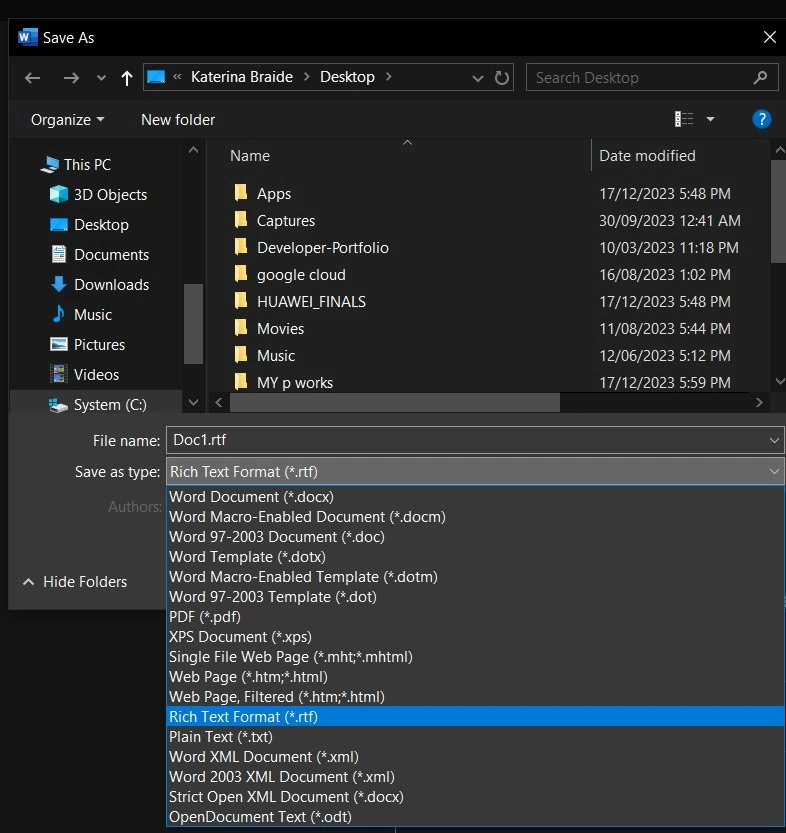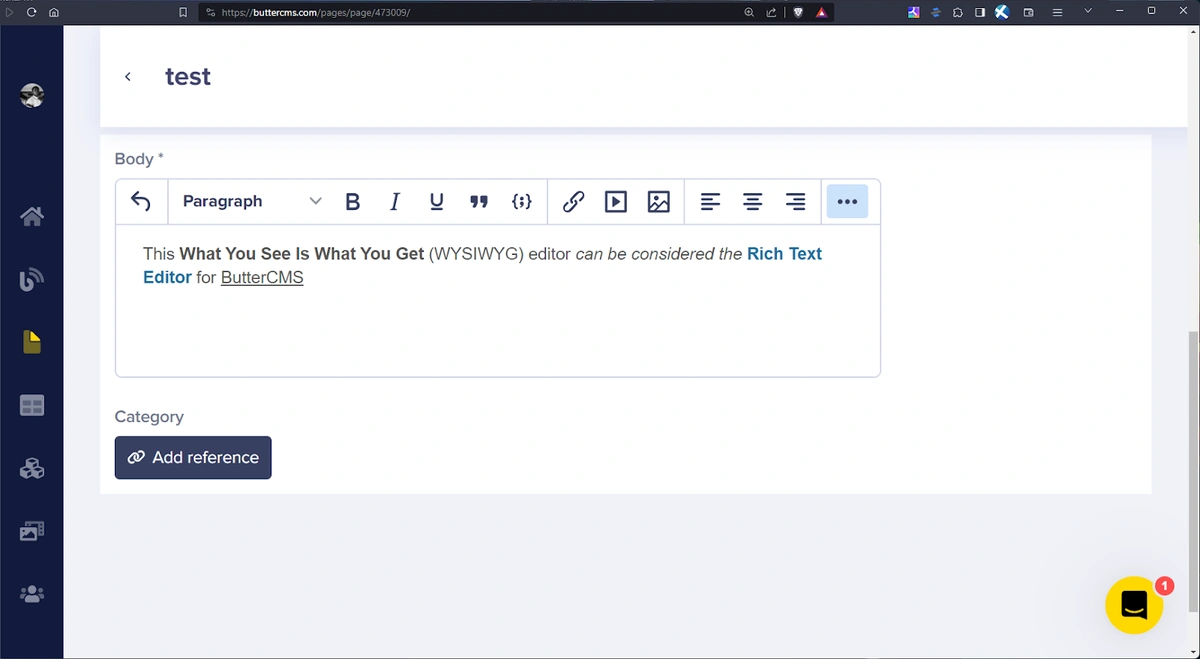
GSD
What is Rich Text Format?
Posted by Miracle Onyenma on January 11, 2024
In the world of digital content, Rich Text Format emerges as a dynamic tool, offering a versatile approach to text composition. It goes beyond plain text, introducing formatting and styling features crucial for presenting content in a more versatile manner without intricate coding.
In this brief article, we’ll explore Rich Text and discover how we can use it to elevate content presentation.
Table of contents
What is Rich Text Format?
Rich Text Format (RTF) refers to a digital text format that goes beyond Plain Text by allowing formatting and styling features. With Rich Text, you can include various markups and formatting features such as bold or italic text, different font sizes, colors, lists, block quotes, etc. This makes the Rich Text more visually expressive and versatile.
What is considered Rich Text?
Let’s take a look at the main manifestations of Rich Text Format in everyday applications:
Rich Text Format for word processors
In this case, we have RTF as a file format that lets us exchange files between different word processors across different operating systems.
This means we can create an .rtf document in Microsoft Word, a popular word processor, and open it in another word processor such as Google Docs..
Here’s an example of saving a document in Rich Text Format in MS Word:
Saving in Rich Text Format in MS Word
These files are encoded in ASCII (American Standard Code for Information Interchange), which is the most common character encoding format for text data across all computers and on the internet.
Rich Text in Content Management Systems
In Content Management Systems (CMSs), Rich Text, often represented by a field type, lets users style content visually without coding. It's like using a fancy word processor where you can make text bold, italic, add lists, and even insert images or videos. CMSs often have a WYSIWYG editor, allowing easy content manipulation without needing to know HTML or CSS. Behind the scenes, CMSs might use markup languages like HTML, JSON, or Markdown for consistency across devices and browsers.
Examples
Here are a few examples of Rich Text in action:
Rich Text in a simple word processor (Wordpad):
In word processors like Wordpad, as we can see in the image below, we can add text formatting and save our document in .rtf format, which can be opened in another word processing application with its formatting retained.
Rich Text Editor in a CMS (the WYSIWYG Editor in ButterCMS):
Here, we can see the Rich Text Editor of ButterCMS, which allows us to add formatting to our text.
With this field/editor, we can view the source code, HTML in this case. In other CMS platforms, it might be Markdown, JSON, or some other format.
As we can see in the image above, the formatted text corresponds to HTML code and not a .rtf file. This HTML code can now be used in web applications to display content.
What is the difference between Rich Text Format and Plain Text?
Plain Text, or a .txt file, is a non-encrypted text that features only text, such as words, numbers, and basic symbols. It’s human-readable as opposed to machine-readable binary data or formatting markup. It is a simple, raw text with no formatting, special symbols, or encryption.
RTF and Plain Text (.txt) take different approaches to serving specific needs.
-
Formatting capabilities: Plain Text keeps it simple—no bold or italics. Rich Text Format offers more choices, allowing bold, italics, underlining, font styles, colors, and diverse text structures.
-
Clarity and simplicity: Plain Text stays basic for universal readability. Rich Text Format adds formatting as the user requires for specific uses such as emphasis or visual distinction. This enhances the overall clarity and readability of the text, allowing for nuanced expression and effective communication.
-
File size differences: Plain Text files are smaller due to no added formatting. Rich Text Format may be larger, especially with extensive formatting.
-
Use cases: Rich Text Format is commonly used in word processing for sharing formatted documents. Plain Text excels where universal readability matters, like in programming code or communication.
-
Objects and media: Unlike Plain Text, which only contains text, Rich Text Format lets you add photos, tables, and more to documents.
In summary, choose RTF for visual expressiveness and Plain Text for simplicity and universal readability based on your task's needs.
Why use Rich Text Format?
There are various reasons why one should use Rich Text Format. Here are a few:
-
Versatile formatting options: RTF offers a rich array of formatting choices, including bold, italics, strikethrough, and subscript. It also provides diverse styles like Paragraph styles, including left, right, and center justification; Character styles, Table styles, and List styles, etc.
-
Cross-platform compatibility: RTF ensures consistent document presentation across different operating systems, simplifying sharing.
-
Easy editing: RTF facilitates easy editing of text, styles, and layout while preserving the original format in untouched areas of the document. This ensures consistent appearance and structure even after edits.
-
CMS enhancement: In CMS platforms, rich text editors support images, tables, and visual elements, enhancing data structure and content experience.
-
Adaptability: Versatility allows RTF to balance complexity and simplicity, making it adaptable for various content needs.
-
Effective for indexing and archiving: Readable by both computers and humans, RTF files are effective for indexing and archiving purposes.
How to use Rich Text
Follow these general guidelines for using Rich Text:
-
Text editors, word processors, and CMSs: For text editors and word processors, open an RTF-compatible application like LibreOffice or Microsoft Word and start entering your text. Within a Content Management System (CMS), such as ButterCMS, you will likely use a Rich Text editor within a page or blog post. Navigate to your page or blog post and begin inputting your text.
-
Formatting text: Highlight text and use the available formatting choices you need, such as bold, italics, underline, font styles, and color.
-
Inserting images and objects: Add images or objects as needed and follow software-specific instructions.
-
Cross-platform compatibility: Ensure compatibility across word processors and different operating systems (OS) by saving your work in RTF. Although not the default for many word processors, select RTF in the "Save As" or "Export" menu. In CMS platforms, you can verify the language or technology used under the hood, like HTML, JSON, or Markdown, which can be used across multiple web and mobile apps.
Opt for plain text in note-taking and avoid using RTF in programming, web development, text-only contexts, or structured data to prevent complications or formatting loss.
Advantages of using Rich Text Format
Below are some advantages of using Rich Text Format
-
Retaining formatting: RTF preserves document structure, including fonts, colors, and photos, ensuring consistent appearance across platforms.
-
Usability and accessibility: Readable across platforms, RTF is suitable for indexing, data extraction, and archiving, catering to both computers and human readers.
-
Improved user experience in CMSs: Rich Text in Content Management Systems built on HTML, JSON, or Markdown provides a user-friendly interface, offering real-time previews for enhanced content presentation.
-
Images and objects: RTF allows for the insertion of objects and images into the document.
-
Rich Text editing: It allows for rich text editing, enabling the creation of visually appealing documents such as reports, newsletters, flyers, or resumes.
Consider RTF's benefits based on specific project needs, emphasizing compatibility, formatting, and appearance.
Limitations of using Rich Text Format
Some limitations that come with using Rich Text Formatting include:
-
Unsuitable for web content and coding: Web pages require specific markup languages, such as HTML, CSS, and JavaScript, designed to be interpreted by web browsers. However, browsers cannot interpret RTF as a file format (.rtf), so while the files may contain various formatting elements such as fonts, colors, and styles, they are unsuitable for writing web pages. A CMS Rich Text editor can be used to create documents suitable for the web since the underlying technologies are usually built on the same technologies as the web.
-
Large file sizes: Documents with extensive formatting in RTF may become unwieldy and larger in size, posing performance concerns during handling.
-
Limited support for media: Some versions of RTF cannot handle media elements and other objects like tables and charts that most word processors support, making it unsuitable for documents with complex multimedia content. More information on versions of RTF and their features can be found here.
-
Limited formatting options: Compared to certain word processing formats, RTF may lack advanced formatting choices like Word Art, LateX support, offset measure options for super- and subscript fonts, etc.
Consider these limitations based on your unique use case and specifications. Alternative document formats may be better suited for specific tasks, depending on your requirements.
Wrapping up
To sum it up, Rich Text Format (RTF) is handy for sharing documents across different systems and creating visually appealing content, especially in Content Management Systems. Using Rich Text comes with many advantages and some limitations, so keep these pros and cons in mind to pick the right tool for your needs, whether you're making eye-catching documents or working with code.
ButterCMS is the #1 rated Headless CMS
Related articles
Don’t miss a single post
Get our latest articles, stay updated!















Miracle Onyenma is a designer and front-end developer obsessed with crafting and sharing beautiful experiences. ✨